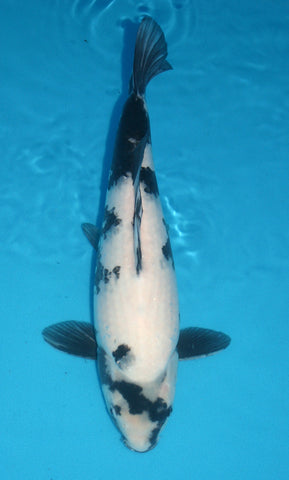Just like in Japan, we have mud ponds which we use to grow our fish in over the summer months. Some of our mud ponds are used just for fry in their first season but two of them are used for growing on the small percentage of Koi that we feel are of a high enough quality for us to continue growing them for another season or more.
We produce over half a million fry to one inch each year and each of those fry are harvested and selected through several times within the first few months of their lives resulting in just 2,000 of them being chosen to go into our indoor growing on facility over the winter. This 2,000 will be reduced by half at the beginning of the following year and from the 1,000 remaining, around 600 will be chosen to be grown on for a second summer in one of our growing on ponds. For us to keep a Koi for that length of time it has to be something quite special but there are plenty of fish which go into our sales tanks simply because we don’t have room to grow them all on – it’s a tough choice but one that we have to make at every stage of selection. Our last mud pond is for growing on the very few Koi that we choose to grow on for a third summer, and on rare occasions a fourth or fifth summer, and in 2009 we chose just 50 fish to go into this pond.
In May 2009 at our annual Koi Quest Day that we hold for members of the internet chat forum “Koi Quest”, we allowed some of our customers who bought fish from us on that day, to put back into the mud pond the Koi that they had just bought. Those customers were then invited to the harvest day in mid September to see their Koi emerging from the pond after a long summer and to see what if any improvement their fish had undergone in that time. It’s an interesting exercise for us because looking after your own fish is one thing but looking after fish that belong to someone else is another thing entirely and we feel an added sense of responsibility. There are always amongst these Koi some which quite frankly could have gone either into a sales tank or back into the mud pond for a further season and so it’s a chance for us to see if we made the right decision when we decided to sell them in the Spring!
Three of the fish that went back into the mud pond for the summer were featured in the article about the Koi Quest Day that appeared in Koi Carp Magazine earlier in 2009.

Sanke 52 cm- Chris Penn

Sanke 49 cm – Eric Littlewood

Shiro Utsuri 39 cm – Andy Humphreys
On 14th September we harvested both of our growing on ponds with around 20 customers looking on – all of them waiting to see what had happened to the fish that they had bought from us back in May. Before we harvested the pond with their fish in however we also had to harvest our Nisai! There was no shortage of willing helpers fortunately and once this was done, and with a stop for lunch, we moved on to the pond everyone had been waiting for which contained the fish they had bought from us earlier in the year. Once again the guys pitched in to help with the harvest and one by one their Koi and ours emerged from the water.
We were very lucky to have the company of quite a few friends (including Mark Griffiths, Myles Sharman, Bob Hart, Chris Gabay and Andy Humphreys) most of whom have helped us harvest our ponds over the years, and with their experienced hands we were able to smoothly and carefully transfer all of the Koi safely from the mud pond. The process involved Mark lifting each Koi by hand from the water and into a floating paddling pool with clean water in it, before putting each Koi into a plastic bag. The bag was then lifted away from the pond and the Koi transferred into to a clean bowl of water next to the transport tank. Myles then had the job of lifting each Koi by hand from the bowl and into the transport tank itself. Once full, the transport tank was then taken as close as possible to the indoor tanks and each Koi was transferred into a plastic bag once again and lifted into the waiting tank.





As soon as each Koi emerged from the pond I took the opportunity to make sure that Mark posed for a quick picture with the fish. Normally when holding a Koi it is good practice to hold it with the nose pointing towards your body, as it is easier for the person holding it and safer for the Koi, but unfortunately it doesn’t present the fish in the best position for taking pictures so Mark very kindly makes life more difficult for himself by turning each fish around so that I can get a better picture – it isn’t as easy as he makes it look but he always does it with a smile!

The picture below shows the Sanke, belonging to Chris Penn, as it emerged from the mud pond looking just as lovely and a few centimetres bigger at 55 cm. This fish was already Sansai when it went into the mud pond and it is important to remember that Koi produce the most growth hormones in their first three years of life. After that, whilst they still continue to grow, it is not at the same remarkable rate as before and changes become more subtle. It was interesting to see how those fish that went into the mud pond as sansai and came out as yonsai took on a fuller and more graceful appearance overall.

Eric Littlewood’s Sanke measured 53 cm when harvest. It’s a beautiful example of its variety with Tsubo sumi on the shoulder, great shiroji and just the right amount of hi curving gently just below the eyes.

Andy Humphreys’ Shiro Utsuri emerged as a Sansai at 47 cm. This fish has definitely grown in length and has maintained a good body shape in the process. Remember, this is by no means a “finished” fish and the body in particular will continue to broaden giving a fuller more pleasing shape.

One of the Koi from the judging competition that we held back in May was bought by Bob Grinyer and put out into the mud pond to be grown on. This Koi has shown a marked improvement, growing from 35 cm to 43 cm and its body shape has also filled out during its time in the mud pond. The motoguru has begun to recede as expected and over time should reduce still further to give a pleasing balance between Shiroji and Sumi on both pectoral fins.

Spring 35 cm

Autumn 43 cm
A Goromo bought by Bob Hart and put back into the mud pond to be grown on is one of the same fish that Bob himself helped to harvest back in 2007 – little did he know back then that he would end up owning it!


Here is Bob inspecting his Koi, now at 52 cm, before taking it home.
Some of the Koi that we harvested in September were ones that we have been watching over the years and it’s always nice to look back at the library of photographs that we have and compare how these fish have progressed.
One in particular was this Goromo which has been photographed at every autumn harvest over the last three years, starting in October 06 when it was about 19 cm in length.
2006 19 cm

2007 46 cm

2008

2009 61 cm
By photographing Koi at different stages in their life we can see how they develop. The difference in size between Koi at nisai and at sansai can be quite significant and, whilst the changes in body shape are more difficult to measure, the overall appearance of Koi as they mature is more pleasing. It is a lesson in itself that one should not look for a mature Koi body shape in a young Koi. Keeping Koi requires patience and time – usually years before you can really begin to appreciate their development. Taking pictures over a period of time helps to remind us just how far these Koi have come and validates the way that they have been selected and raised, not just for us as a breeder but for the hobbyist.
We don’t normally offer to grow on Koi that have already been transferred into our sales tanks and it is something that has been a unique opportunity, only available on the Koi Quest Day, but I think that it has been an enjoyable experience for those that have taken part and has given them an insight into exactly what is involved in harvesting a mud pond, a chance to get in the water with some waders on if they are very lucky, a sense of great anticipation waiting for their Koi to emerge from the water, and an opportunity to be part of what is without a doubt one of the most exciting days on any Koi farm’s calendar.


